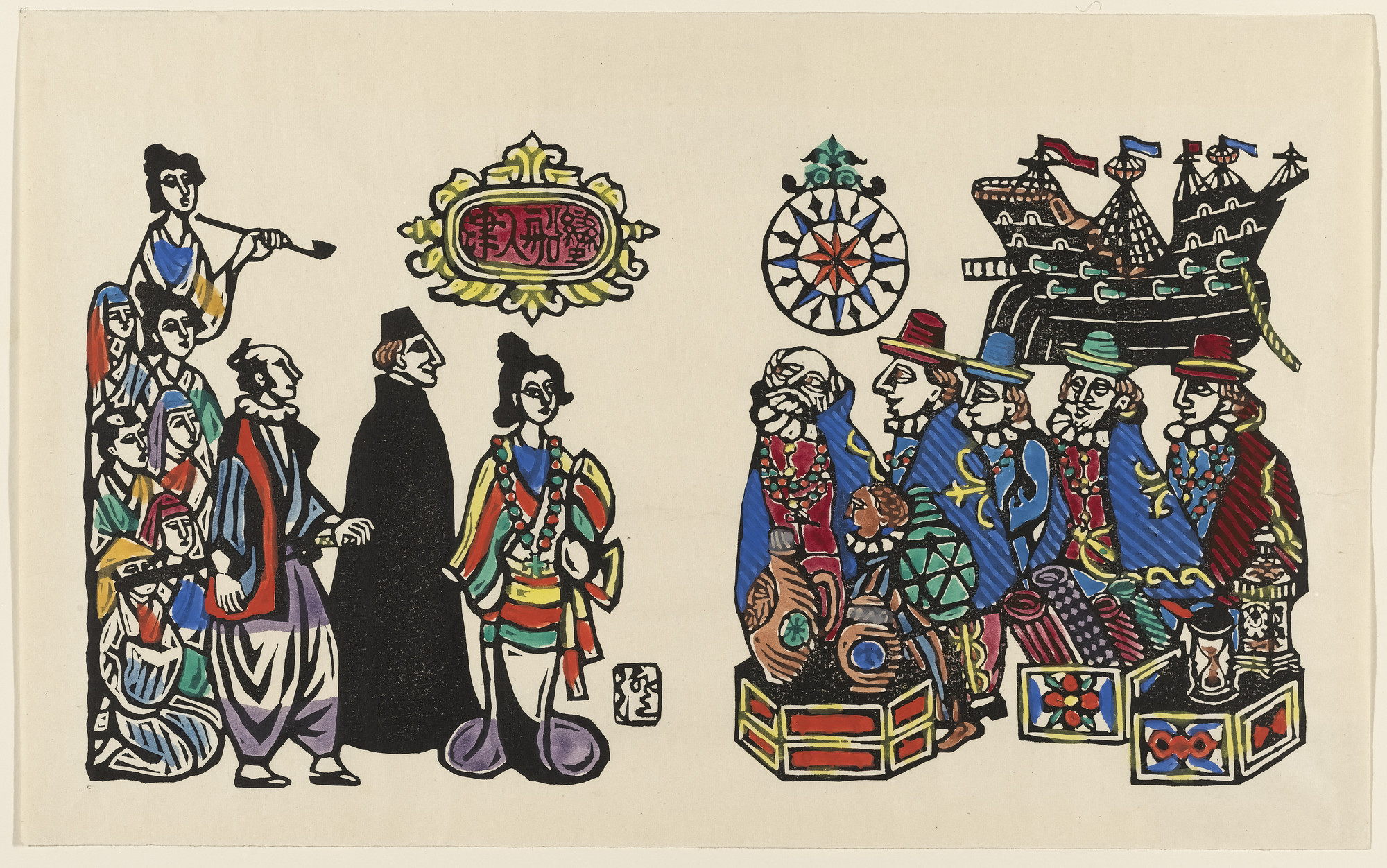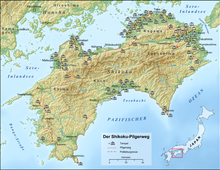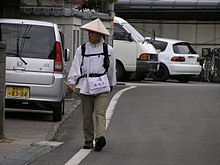
「四國遍路」Hikikomori Pilgrimage.1,200 km. A pilgrimage across Shikoku to reclaim life beyond isolation. 1200週年;Oliver STATLER: Japanese Pilgrimage;Modern Japanese Prints: An Art Reborn. The Shikoku Pilgrimage (四国遍路 Shikoku Henro) or Shikoku Junrei (四国巡礼)
四國遍路並不只是出於宗教目的。作為增進健康和巡訪靈地的旅遊路線,它也受到了年輕人的歡迎。還有越來越多的外國人專程前來體驗。當地認為四國遍路並非單純的信仰現象,而是日本重要的「文化遺產」,正積極推動旨在申報聯合國教科文組織(UNESCO)世界遺產的相關準備。
https://www.nippon.com/hk/views/b03202/
Five men. 1,200 km. A pilgrimage across Shikoku to reclaim life beyond isolation.


https://www3.nhk.or.jp/nhkworld/en/shows/3026038/......
Documentary 360
Hikikomori Pilgrimage
NIPPON.COM
「四國遍路」1200週年,受到海外關注的日本巡禮
四國遍路之旅始於德島縣第一處靈地(札所)「靈山寺」,途經高知、愛媛兩縣,終於香川縣的第88處靈地「大窪寺」。行程最短也有1,130km,徒步需時約40天,乘坐巴士或電車需10天。
Oliver Statler - 2012 - Art
Oliver Statler. 59. Arrival of a Portuguese Ship (1952) 60. Nambanesque Behavior (1955) 61. Devils (1952) 62. Landscape (1952) 63. The White Horse.漢字只出現在索引。
Kawakami Sumio Japanese, 1895–1972
Nanban art (南蛮美術) refers to Japanese art of the sixteenth and seventeenth centuries ... The Namban Art of Japan. ... Namban: Art in Viceregal Mexico. Turner.
Nanban art refers to Japanese art of the sixteenth and seventeenth centuries influenced by contact with the Nanban or 'Southern barbarians', traders and missionaries from Europe and specifically from Portugal. Wikipedia
蠻船入津
台灣現在可能叫 大船入港

Kawakami SumioThe Arrival of the South Savages1952
MediumWoodcutDimensionscomposition: 12 1/8 x 22 7/16" (30.8 x 57cm); sheet: 15 5/16 x 24 13/16" (38.9 x 63cm)
Nambanesque?南蠻風
ile:KAWAKAMI Nambanesque-behavior.jpg

Japanese Pilgrimage Oliver Statler
| ||
|
| ||
| ||
| Japanese Pilgrimage. Oliver STATLER. This is the grandfather of all English language books written about the pilgrimage. He spent about three months walking the pilgrimage in 1971 and this is a thoughtful and insightful accounting of that trip and another partial trip in 1968, with enough history (although partly fictionalized) to help us understand the big picture. An absolute 100% must read for anyone contemplating walking the pilgrimage. Pan Books, 1984 ----- |
From Wikipedia, the free encyclopedia
Map all coordinates using: OpenStreetMap
Download coordinates as: KML · GPX

Map of the 88 temples along the Shikoku Pilgrimage

Pilgrims at Zentsū-ji, Temple 75 and the birthplace of Kūkai

An aruki-henro or walking pilgrim, marked out by his distinctive sedge hat, white shirt, and kongō-zue. The henro-michi route passes through the countryside and a number of cities.

The Shikoku Pilgrimage (四国遍路 Shikoku Henro) or Shikoku Junrei (四国巡礼) is a multi-site pilgrimage of 88 templesassociated with the Buddhist monk Kūkai (Kōbō Daishi) on the island of Shikoku, Japan. A popular and distinctive feature of the island's cultural landscape, and with a long history, large numbers of pilgrims, known as henro (遍路), still undertake the journey for a variety of ascetic, pious, and tourism-related purposes.[1] The pilgrimage is traditionally completed on foot, but modern pilgrims use cars, taxis, buses, bicycles, or motorcycles. The standard walking course is approximately 1,200 kilometres (750 mi) long and can take anywhere from 30 to 60 days to complete.
In addition to the 88 "official" temples of the pilgrimage, there are over 20 bangai — temples not considered part of the official 88. To complete the pilgrimage, it is not necessary to visit the temples in order; in some cases it is even considered lucky[citation needed] to travel in reverse order. Henro(遍路) is the Japanese word for pilgrim,[2] and the inhabitants of Shikoku call the pilgrims o-henro-san (お遍路さん), the o (お) being an honorificand the san (さん) a title similar to "Mr." or "Mrs.". They are often recognizable by their white clothing, sedge hats, and kongō-zue or walking sticks. Alms or osettai are frequently given. Many pilgrims begin and complete the journey by visiting Mount Kōya in Wakayama Prefecture, which was settled by Kūkai and remains the headquarters of Shingon Buddhism. The 21 kilometres (13 mi) walking trail up to Koya-san still exists, but most pilgrims use the train.
Contents
1History
1.1Background
1.2Kōbō Daishi
1.3Development
2Practice
2.1Stages
2.2Equipment
2.3Rites
3Imitative versions
4Temples
5See also
6References
7Further reading
8External links
Japanese Pilgrimage [Hardcover]

Oliver Statler (Author)
1960
Map all coordinates using: OpenStreetMap
Download coordinates as: KML · GPX

Map of the 88 temples along the Shikoku Pilgrimage

Pilgrims at Zentsū-ji, Temple 75 and the birthplace of Kūkai

An aruki-henro or walking pilgrim, marked out by his distinctive sedge hat, white shirt, and kongō-zue. The henro-michi route passes through the countryside and a number of cities.

The Shikoku Pilgrimage (四国遍路 Shikoku Henro) or Shikoku Junrei (四国巡礼) is a multi-site pilgrimage of 88 templesassociated with the Buddhist monk Kūkai (Kōbō Daishi) on the island of Shikoku, Japan. A popular and distinctive feature of the island's cultural landscape, and with a long history, large numbers of pilgrims, known as henro (遍路), still undertake the journey for a variety of ascetic, pious, and tourism-related purposes.[1] The pilgrimage is traditionally completed on foot, but modern pilgrims use cars, taxis, buses, bicycles, or motorcycles. The standard walking course is approximately 1,200 kilometres (750 mi) long and can take anywhere from 30 to 60 days to complete.
In addition to the 88 "official" temples of the pilgrimage, there are over 20 bangai — temples not considered part of the official 88. To complete the pilgrimage, it is not necessary to visit the temples in order; in some cases it is even considered lucky[citation needed] to travel in reverse order. Henro(遍路) is the Japanese word for pilgrim,[2] and the inhabitants of Shikoku call the pilgrims o-henro-san (お遍路さん), the o (お) being an honorificand the san (さん) a title similar to "Mr." or "Mrs.". They are often recognizable by their white clothing, sedge hats, and kongō-zue or walking sticks. Alms or osettai are frequently given. Many pilgrims begin and complete the journey by visiting Mount Kōya in Wakayama Prefecture, which was settled by Kūkai and remains the headquarters of Shingon Buddhism. The 21 kilometres (13 mi) walking trail up to Koya-san still exists, but most pilgrims use the train.
Contents
1History
1.1Background
1.2Kōbō Daishi
1.3Development
2Practice
2.1Stages
2.2Equipment
2.3Rites
3Imitative versions
4Temples
5See also
6References
7Further reading
8External links
Japanese Pilgrimage [Hardcover]

Oliver Statler (Author)
1960
Modern Japanese Prints: An Art Reborn: Oliver Statler: Amazon.com
https://www.amazon.com/Modern-Japanese-Prints-Art-Reborn/dp/B001362CRY- Publisher: Charles E. Tuttle Company; Seventh Printing edition (1960)
- ASIN: B001362CRY
- Package Dimensions: 10.5 x 7.3 x 1.1 inches



沒有留言:
張貼留言